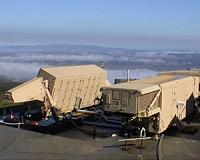 |
Jerusalem (UPI) Jul 27, 2010 Israel said it will buy more Iron Dome interceptors after it deploys the controversial anti-missile system starting in November, the defense ministry said. Iron Dome is designed to combat short-range missile threats from the Gaza Strip and Lebanon, specifically rockets and artillery shells of which Hamas and the Hezbollah have fired thousands at Israel in the past. First deployment will be along the border of the Hamas-run Gaza Strip from where homemade rockets are fired daily into Israel. After deployment along the Gaza border, it will be used along the Lebanese border, where the Israeli government believes Hezbollah has an inventory of more than 40,000 rockets ready to be fired at Israel. Recent tests of the system have proved very successful, the ministry said. "The Iron Dome interceptor, in conjunction with air force and anti-aircraft systems, successfully downed a large number of threats in fully operational mode," a ministry said in statement. "The first two batteries will become operational in November 2010" and "the defense ministry will soon place orders for additional batteries." "We will act to actively deploy the batteries in the field as soon as possible," Defense Minister Ehud Barak said. But criticism of the system has focused on its development costs, which have risen around 40 percent in the past year. In December 2007, the Israeli Cabinet approved $206 million for development Iron Dome, led by manufacturer Rafael. The project received a much-needed cash injection in May when U.S. President Barack Obama approved $205 million in special aid for Israel to establish 10 control centers for operating the system. Of concern also has been the high cost of the individual interceptor missiles compared with the lost-cost, low-tech Qassam rockets from Gaza and multiple-launch rocket mortars from Southern Lebanon. Qassam rockets were developed by the Izz ad-Din al-Qassam Brigades, the military arm of Hamas. The range of the three models, from nearly 3 feet to 6 feet, 7 inches, is from 2 miles to just more than 6 miles. Construction of a Qassam is very simple. A steel plate that forms and supports the nozzles is spot-welded to the base of the cylinder. The simple metal shell warhead surrounds explosives and is triggered by a fuse using a simple firearm cartridge, a spring and a nail. But because Qassam rockets aren't canted, they don't spin during fight and so are much less accurate than an Iron Dome interceptor. A report by the German magazine Spiegel, which visited a Qassam factory in Gaza in early 2008, said the cost or Qassam is around $645 for the largest version. Many of the raw materials are smuggled in through tunnels connected to Egypt. Some critics have suggested the best weapon to use against Hamas rockets is Raytheon's Mark 15 Phalanx Close-In Weapons System. It is the missile defense weapon of last resort of the U.S. Navy and has been increasingly used by the U.S. Army in Iraq. Interest in the Phalanx CIWS stirred in Israel in fall 2006 following the massive Katyusha rocket mortar bombardment of northern Israel by Hezbollah in its brief conflict.
Share This Article With Planet Earth
Related Links Learn about missile defense at SpaceWar.com Learn about nuclear weapons doctrine and defense at SpaceWar.com All about missiles at SpaceWar.com Learn about the Superpowers of the 21st Century at SpaceWar.com
 THAAD Radar Performs Successfully In Missile Defense Test
THAAD Radar Performs Successfully In Missile Defense TestTewksbury MA (SPX) Jul 27, 2010 The Terminal High Altitude Area Defense (THAAD) radar built by Raytheon performed successfully in the latest integrated THAAD flight test. The test, conducted by the Missile Defense Agency and Lockheed Martin, THAAD prime contractor and system integrator, occurred at the Pacific Missile Range Facility in Hawaii June 29, 2010. The test marks the seventh successful intercept of a threat-repr ... read more |
|
| The content herein, unless otherwise known to be public domain, are Copyright 1995-2010 - SpaceDaily. AFP and UPI Wire Stories are copyright Agence France-Presse and United Press International. ESA Portal Reports are copyright European Space Agency. All NASA sourced material is public domain. Additional copyrights may apply in whole or part to other bona fide parties. Advertising does not imply endorsement,agreement or approval of any opinions, statements or information provided by SpaceDaily on any Web page published or hosted by SpaceDaily. Privacy Statement |